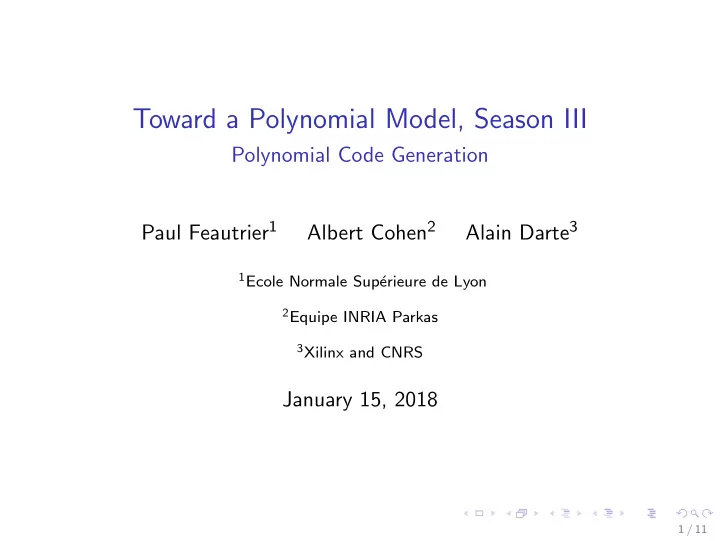

Toward a Polynomial Model, Season III Polynomial Code Generation Paul Feautrier 1 Albert Cohen 2 Alain Darte 3 1 Ecole Normale Sup´ erieure de Lyon 2 Equipe INRIA Parkas 3 Xilinx and CNRS January 15, 2018 1 / 11
Polynomials Everywhere ◮ The polyhedral model deals only with affine forms i.e. polynomials of degree one. ◮ Polynomials are needed: ◮ If present in the source e.g. when computing distances ◮ After evalation of induction variables ◮ After linearization of arrays ◮ When counting messages, operations, memory cells .... 2 / 11
Mathematical Background Needed: an equivalent of Farkas lemma for building positivity certificates. ◮ Semi-algebraic sets: S = { x ∈ R n | p i ( z ) ≥ 0 , i = 1 , n } where the p i are p olynomials. ◮ Theorems by Handelman, Schweighofer, Putinar: ◮ Schweighofer products: g α ( x ) = p 1 ( x ) α 1 ... p n ( x ) α n . ◮ P ( x ) is stricly positive in S iff it is a positive linear combination of Schweighofer products ◮ Minor conditions: S must be compact and the g i must generate all polynomials. ◮ Note that there is no integral version of these theorems. 3 / 11
Mechanics Expand the master equation: � P ( x ) = λ α g α , λ α ≥ 0 , α ◮ Equate coefficients of like monomials ◮ The result is a linear system of equations in the λ s to be solved in positive unknowns by any linear program solver. ◮ Linear solvers are very powerful and can tackle problems with thousands of constraints and unknowns. ◮ Since one must limit the number of Schweighofer products, the problem is only semi-decidable. 4 / 11
The OpenStream Language stream s, t; reset task reset{ write once into s; //theta() = 0 } for(i=0;;i++) writer task task writer{ //theta(i) = i+1 read once from s; write pointer write once into s; stream write once into t; read pointer } synchronization for(i=0;; i++) reader task task reader{ //theta(i) = i+2 read once from t; } ◮ A stream is a potentially infinite one dimensional array, with a write pointer and a read pointer. ◮ At each read or write, the corresponding pointer is increased by a non negative amount, the burst . ◮ The read pointer cannot overtake the write pointer : synchronization. ◮ Analogy with Unix files and hardware channels. 5 / 11
Dependences and Scheduling ◮ If the control program is polyhedral, one can obtain closed form formulas for pointers by counting task creations using ISCC. The results are polynomials, hence the dependence relation is semi-algebraic. ◮ One can obtain polynomial schedules using Handelman or Schweighofer theorems. ◮ See IMPACT 2015, 2016. 6 / 11
Code Generation Basics ◮ Each thread execute sequentially all instances of one task. ◮ After each instance, the barrier thread execute some barriers . ◮ The number of barriers from the begining of the stream to a given instance must be equal thread to the schedule of the instance. 7 / 11
The Problem of the Decreasing Schedule Since the number of barriers can only increase, task instances must be created in order of increasing schedule. Let ≪ be the execution order of the control program, and θ be the schedule of a task. ◮ If the system of constraints u ≪ v , θ ( v ) < θ ( u ) is unfeasible, the schedule is increasing. ◮ If u ≪ v , θ ( u ) < θ ( v ) , is unfeasible, the schedule is decreasing, the execution order must be reversed. ◮ If both systems are feasible, the schedule is non monotonic. Index set splitting? ◮ If both system are unfeasible, the schedule is constant. 8 / 11
Target Languages: X10 / Habanero clocked finish{ clocked async{ T1; } clocked async{ T2 T1 T2; } clocked async{ advance; T3; T4 T3 } clocked async{ advance; T4; } } 9 / 11
Related Work ◮ Counting Algorithms: Barvinok, Brion, Clauss and the Strasburg school, Ehrhart, Verdoolaege. Note that to the best of my knowledge, there is no equivalent for semi-algebraic sets. ◮ Delinearization, CART, CRP: avoiding polynomials. ◮ Achtziger and Zimmerman on quadratic schedules. ◮ Groesslinger on cylindrical algebraic decomposition. ◮ Clauss et. al. on inverting schedules. 10 / 11
Conclusion and Future Work ◮ An implementation is under way. ◮ Needs to be extended: data parallelism, non monotonic schedules, task body. ◮ OpenStream is an interesting language: hiding non polyhedral code in the task body, HLS. ◮ A small step beyond the polyhedral model ◮ Missing tools: ◮ A projection algorithm (CAD ?) and a transitive closure algorithm ◮ A counting algorithm ◮ A polynomial version of the Cousot-Halbwachs algorithm. ◮ Other Models ?? 11 / 11
Recommend
More recommend